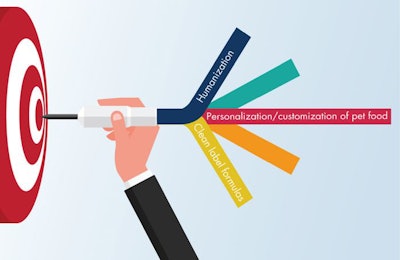
2018 was a busy year for the pet food industry. With a significant uptick in mergers and acquisitions, the growth of the “premium grocery” segment and the continuing rise of eCommerce, the players, price points and purchasing channels have been constantly shifting. As we head into 2019, Petfood Industry asked the experts what we should expect to see in terms of trends and consumer wants in the coming year.
The personalization of pet nutrition
Customized pet food has taken many forms over the years. From life stages to breed-specific and functional formulas, the evolution of catering to increasingly nuanced and demanding pet owners has led to a lot of growth in pet food options. But now, there’s a new emerging trend, a small but growing segment on the superpremium end of pet food: personalized nutrition.
“As the pet food industry continues to follow trends from the human food sector and meet the expectations of millennial pet owners, the Pet Food Institute (PFI) has seen increased interest in personalizing the experience of feeding our pets, such as product formulation for pets of a specific size and age group,” said Dana Brooks, president and CEO of PFI. And in 2019, this interest is expected to go beyond what’s currently on pet store shelves.
“For a long time within pet food there have been premium brands that have offered life-stage-specific foods, but some startups are taking this to an entirely different level, and are creating brands that are catered not just to a dog’s breed or life stage, but to a specific dog,” said Jared Koerten, head of pet care at Euromonitor International. “Looking at things like: does a pet owner’s dog have any specific allergies, what is the activity level they see with their dog, does it have a particular protein it seems to like more. So they fill out this pretty lengthy form and these companies will go out and create a customized food blend specifically for the owner’s dog. And I think that’s really what younger consumers in particular are very interested in; a personalized component and customization. It’s very small at the moment, and you definitely pay a premium for it, but I think you’re going to see a lot more interest and innovation along these lines.”
And even though one of the trends in 2018 that is likely to continue in 2019 is the availability of lower-priced “premium grocery” products as consumers continue to focus on price consciousness, pet food experts see potential in this niche personalization segment — particularly with humanization now the norm for pet owners.
“Within the trend of humanization, pet parents are seeking more customized, premium options such as limited-ingredient diets or culinary experiences — and they’re willing to spend more to fit their needs,” said Chris Butterworth, innovation director at Mars Petcare. “Sales of premium products have dramatically outpaced the growth of value and mainstream products, and 84 percent of market growth is now driven by premiumization, as opposed to volume growth.”
Even pet owners who aren’t able or willing to pay superpremium prices for customized diets want to feel like they’re customizing their pets’ meals, which is why meal enhancers will continue to grow in popularity, according to James Restivo of Nielsen and Maria Lange of GfK. Already a US$93 million category with 25 percent growth year over year, “meal enhancers or ‘meal mixers/toppers’ in 2019 will increasingly be seen as convenient, easy ways to add nutrition/health benefits and easy to prep/feed,” they said.
The interest in clean label continues
The clean movement was one of the top trends to look out for in our 2018 annual trends feature, and “clean” eating for pets continues to be a hot-button topic going into 2019.
“I see the natural, environmentally friendly and clean label trends thriving along with the growth of premium priced pet foods,” said Jeffrey Alix, global marketing manager, pet nutrition, for DSM Nutritional Products. “Although a challenge for North American pet food manufacturers, the GM (genetically modified) topic continues to gain momentum, driven by the unfounded but highly emotionally charged ‘frankenfood’-type consumer messaging associated with the topic.”
“Clean label” takes on a lot of forms in consumer minds these days, including limited ingredients, natural claims and raw/fresh/frozen formulas.
“SuperZoo will continue to see a focus on natural, organic and raw food products, as more and more companies are bringing healthy pet food options to the show floor,” said Jacinthe Moreau, president of the World Pet Association. “That is a trend we expect to steadily grow as more consumers shift toward the clean, raw pet food movement.”
Air-dried products are part of this trend, as well, in spite of the necessary premium pricing.
“We are seeing more ‘air-dried’ products coming out,” said Corby Reese, managing director for Swander Pace Capital. “This manufacturing method has a better perception among pet parents than HPP (high pressure processing) or freeze-dried. It sounds more ‘natural.’ Air-dried diets may bridge the gap between raw and processed foods, combining the best of both: better nutrient preservation but still with a kill-step for pathogens. The downside is that they are expensive so will have a limited appeal by demographic.”
Humanization: The motivation behind all trends to watch
Unsurprisingly, humanization continues to be the driving force behind pet owner decisions when it comes to their furry friends, and understanding that mindset can make it easier to predict coming trends in pet food.
“I think you’re going to see some, at the premium end, more developments that try to connect what we’re eating to what our dogs or cats are eating, and making that an important selling point,” said Koerten. “And then in general, just the continued humanization of pet food formats, whether it’s actual soups for your cats that look like what a human would eat or a stew for your dog.”
All the experts agree that consumer behaviors brought on by pet humanization are key predictors to the direction pet food will continue to take.
“Human eating trends are consistently trickling over into pet foods, with pet parents wanting their pet’s diet to match their own,” said Butterworth. “From clean eating and non-GMO to paleo, this humanization trend has been, and will continue to be, at the forefront of pet food trends.”
















